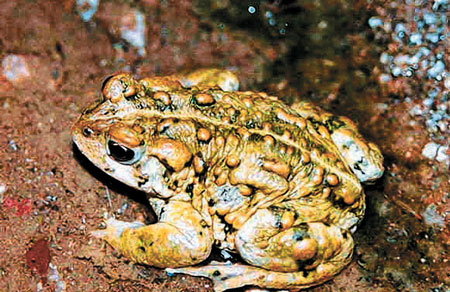Status of Amargosa toad to be studied
The Amargosa toad hopped through a bureaucratic hoop Thursday on its marshy path to federal protection.
In response to a petition filed in February 2008 by two conservation groups, the U.S. Fish and Wildlife Service announced that it will conduct an in-depth status review to determine whether the amphibian warrants protection under the Endangered Species Act.
"This is 32 years overdue for the Amargosa toad," ecologist Daniel Patterson of Public Employees for Environmental Responsibility said.
The group joined the Center for Biological Diversity in requesting protection for the toad, which is found only along a 10-mile stretch of the Amargosa River in the Mojave Desert near Beatty, 120 miles northwest of Las Vegas. Conservationists say the Amargosa toad has warranted protection since 1977.
"There still is hope for recovery of this unique critter and the neat place that it lives," Patterson said.
The petition by the two groups asks that the toad be listed as threatened or endangered. Thursday's announcement triggers a 60-day period of public comment.
Bob Williams, Nevada supervisor for the U.S. Fish and Wildlife Service, said he expects the agency to complete its review in less than 12 months.
The service then will issue a finding that:
• Listing as threatened or endangered is warranted.
• Listing is warranted but precluded by other, higher priorities.
• Listing is not warranted.
An "endangered" listing means an animal or plant faces extinction, while a "threatened" listing means a species is likely to become endangered within the "foreseeable future."
Williams said surveys of the Amargosa toad are conducted every year. Officials estimated that 8,000 Amargosa toads existed in 2001, he said, but that number dropped about five years ago.
"We think the population fluctuates around 5,000 to 6,000 toads," Williams said.
Patterson said the Amargosa toad lives at least 35 miles from any other toad species.
Conservationists say threats to the toad include loss of habitat from development, harm from off-road vehicles, groundwater depletion by mining and harm from non-native species such as crayfish and bullfrogs.
JoLynn Worley, a spokeswoman for the Bureau of Land Management, said the agency has no plans to proceed with its sale of more than 5,000 acres of public land that includes Amargosa toad habitat.
Worley said the bureau has been a participant in the Amargosa Toad Working Group, which brought together state and federal wildlife agencies with biologists, private groups and land owners in nearby Beatty to ensure the toad's continued existence.
She said the bureau has no position on the petition that seeks federal protection for the toad.
"If a species is federally listed, then we follow those rules and protections," the spokeswoman said. However, the bureau has more flexibility to manage land "without a federal listing."
Patterson said the BLM has poorly managed its public land in the toad habitat for years.
Worley declined to comment on that other than to say many factors have contributed to degradation of the habitat.
Patterson called the Endangered Species Act the "most effective tool" for protecting and recovering imperiled wildlife and the places they live.
The ecologist said he expects public sentiment to tip in favor of the Amargosa toad because "people like amphibians" and "they like places where you can find water in the desert."
"I just think people really care," he said. "They care about the creations that are here on Earth."
He also said human beings have an ethical obligation to help a "fellow species in trouble."
Contact reporter Carri Geer Thevenot at cgeer@reviewjournal.com or 702-384-8710.


















